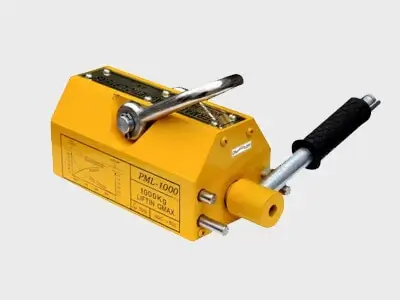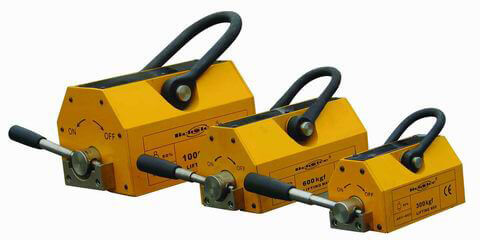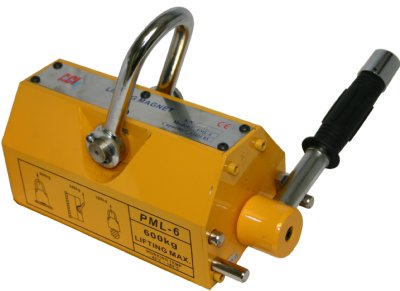
Magnetic grippers with detachable field
magnetic grippers with disconnectable field
Magnetic gripper is a device equipped with magnetic circuit relying on durable sintered neodymium magnets. By utilizing modern design solutions, the separator does not need power supply from outside, giving users independence from grid power that is not always present in facilities. Disconnection and connection takes place by a mechanical lever, making daily operation very convenient. The Magnetic gripper is characterized by small dimensions compared to the force it produces. This gripper magnet can be utilized for lifting, moving, etc. bars, sheets as well as all kinds of elements made of magnetic steel or iron. This is a very effective solution, used in workshops, production halls, warehouses - that means where there is a need to handle heavy, large and impractical objects made of ferromagnetic materials.
The offered magnetic grippers are covered by a one-year warranty. They have a "CE" compliance declaration. The operational level of the magnetic gripper's acoustic pressure does not exceed 70dB, so the device is not treated as a source of noise.
Load Capacity of Magnetic Grippersshould be evaluated taking into account the factors described below:
- During the operation with grippers, attention should be paid to the shape and thickness of the handled elements, as the load capacity of the gripper depends on these parameters of the given element. For each gripper model, we provide the relationship between the load capacity and the thickness of the lifted object. For example, solid cylindrical elements like reinforcement bars, cylinders, etc., reduce the nominal load capacity of the gripper by approximately 50%.
- Please note that the minimum thickness of the lifted element is 2mm. Too thin elements may be bent and damaged. Additionally, they are less attracted due to suboptimal utilization of the gripper's magnetic field, caused by the saturation of the element and the dissipation of most of the field outside the handled element. Accordingly thick elements increase the load capacity efficiency by fully closing the gripper circuit. Below we provide a comparison of optimal steel thicknesses for each gripper model:

Appropriate performance curves that take into account the thickness of the lifted elements are located on the housing of each gripper. For safety reasons, it is necessary to consult the provided data before starting work.

The load capacity of the grippers also depends on the size of the air gap formed between the lifted element and the surface of the device. The gap is formed between the lifted element and the magnetic poles of the gripper. The load capacity efficiency decreases for all elements where the surface roughness parameter Ra exceeds 6.3mm - that is, for most objects, except those with precisely ground and very clean surfaces. For all other elements, the presence of an air gap should be taken into account, assuming, for example:
- for rolled surfaces (rusty) - 0.1-0.3mm,
for porous and uneven surfaces, approximately 0.3-0.5mm.
For each grip model, we provide the load capacity parameter depending on the thickness of the steel and the size of the air gap.
Appropriate performance curves taking into account the air gap are located on the housing of each handle. For safety reasons, it is necessary to consult the given data before starting work.
The load capacity of the handle may be weakened by the elevated temperature of the element and its surroundings. It is not permissible to lift elements with a temperature higher than the working temperature in an environment with a temperature higher than 80°C.
A very important parameter influencing the load capacity of the handle is the material from which the lifted element is made. Different ferromagnetic materials have different magnetic properties and, therefore, interact with the magnet differently. The force of this interaction (attractive force) depends on the structure and chemical composition of the material. Pure iron is naturally attracted the strongest, materials with small impurities, such as carbon steels, are slightly weaker, while cast iron is significantly weaker. The general rule is that the more iron in the material, the greater the load capacity of the handle. For example, for low-carbon steel, the efficiency coefficient is 0.95, for high-carbon steel - 0.90, for low-alloy steel - 0.75, and for cast iron - 0.50.
* it should be noted that the values given in the table for a given material are subject to modifications due to the thickness of the element, surface quality, shape, and temperature described above.
Subcategories:
CM PML-3 / N45 - magnetic gripper
Catalog no 100226
GTIN: 5906301812623
Weight
9400 g
Magnetization direction
↑ axial
Lifting Capacity
300 kg / 2941.99 N
CM PML-6 / N45 - magnetic gripper
Catalog no 100477
GTIN: 5906301812630
Weight
17900 g
Magnetization direction
↑ axial
Lifting Capacity
600 kg / 5883.99 N
CM PML-10 / N45 - magnetic gripper
Catalog no 100478
GTIN: 5906301812647
Weight
33300 g
Magnetization direction
↑ axial
Lifting Capacity
1000 kg / 9806.65 N




